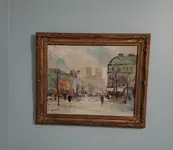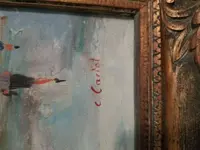- Joined
- Dec 23, 2019
- Messages
- 6,363
- Reaction score
- 20,245
- Golden Thread
- 0
- Location
- Surrey, UK
- Primary Interest:
- All Treasure Hunting
- #1
Thread Owner
I thought you might be amused by this, which has parallels to some of the discussions that happen here on Treasurenet (and other sites).
I was listening to a violin expert being interviewed on the radio. He’d been at the Victoria & Albert Museum in London on a day when the general public could bring in their own items for assessment and – since the museum was running a special exhibition of musical instruments – he joked that they’d been knee-deep in ‘Stradivarius’ violins. The interviewer asked if anything valuable had turned up. He laughed and said no, before recounting a conversation with a visitor which went something like this:
Good morning. What do you have to show us?
An early Stradivarius violin.
Well, let’s take a look… hmmm… no that’s a modern violin. It’s not a Stradivarius, I’m afraid.
Yes it is! You didn’t spot the label through the sound holes. It clearly says “Stradivarius”.
Yes, I saw that. It’s a fantasy label. It also says “Made in Czechoslovakia”. The Stradivarius workshop was in Cremona, in Italy.
Yes, I know. I’ve been researching this on the web and I found a reference that Antonio Stradivari went on holiday to Czechoslovakia with his family in the summer of 1656. He probably made it while he was there.
Antonio Stradivari was born in 1644. He would have been twelve years old.
Yes, so not only is it rare because it was made outside Italy, but it must be one of his earliest instruments. Like an apprentice piece, or something.
It says “Made in Czechoslovakia” in English.
Yes, almost certainly made for export .
It’s a modern instrument. The state of Czechoslovakia didn’t exist under that name until 1918, when the First World War ended. Before that it was Bohemia and Slovakia. It’s not a Stradivarius.
Well, that’s what you say but it looks just like the ones I’ve seen on the web. I’ll take it to an expert.
I am an expert actually. I’ve handled a lot of authentic instruments.
Well, thanks anyway, but I know what it is. I’ll keep researching.
I was listening to a violin expert being interviewed on the radio. He’d been at the Victoria & Albert Museum in London on a day when the general public could bring in their own items for assessment and – since the museum was running a special exhibition of musical instruments – he joked that they’d been knee-deep in ‘Stradivarius’ violins. The interviewer asked if anything valuable had turned up. He laughed and said no, before recounting a conversation with a visitor which went something like this:
Good morning. What do you have to show us?
An early Stradivarius violin.
Well, let’s take a look… hmmm… no that’s a modern violin. It’s not a Stradivarius, I’m afraid.
Yes it is! You didn’t spot the label through the sound holes. It clearly says “Stradivarius”.
Yes, I saw that. It’s a fantasy label. It also says “Made in Czechoslovakia”. The Stradivarius workshop was in Cremona, in Italy.
Yes, I know. I’ve been researching this on the web and I found a reference that Antonio Stradivari went on holiday to Czechoslovakia with his family in the summer of 1656. He probably made it while he was there.
Antonio Stradivari was born in 1644. He would have been twelve years old.
Yes, so not only is it rare because it was made outside Italy, but it must be one of his earliest instruments. Like an apprentice piece, or something.
It says “Made in Czechoslovakia” in English.
Yes, almost certainly made for export .
It’s a modern instrument. The state of Czechoslovakia didn’t exist under that name until 1918, when the First World War ended. Before that it was Bohemia and Slovakia. It’s not a Stradivarius.
Well, that’s what you say but it looks just like the ones I’ve seen on the web. I’ll take it to an expert.
I am an expert actually. I’ve handled a lot of authentic instruments.
Well, thanks anyway, but I know what it is. I’ll keep researching.



 Ive had to work hard for everything I got in life and sometimes you wonder when something lucky like that will fall into your lap? Probably never but keep dreaming. My wife likes the painting so hung it in spare bedroom.
Ive had to work hard for everything I got in life and sometimes you wonder when something lucky like that will fall into your lap? Probably never but keep dreaming. My wife likes the painting so hung it in spare bedroom.


